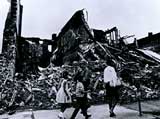Race Riots
Tensions are high across the country, and race riots occur in many cities, not just in the South. In the summer of 1964, there are violent incidents in New York City; Rochester, New York; Paterson and Elizabeth, New Jersey; Dixmoor, Illinois; and Philadelphia. One of the worst race riots in U.S. history erupts in Watts, a predominantly black section of Los Angeles, in August 1965. It lasts for five days.
In the summer of 1966, there are riots in Chicago and Waukegan, Illinois, and Lansing, Michigan. A state of emergency is declared in Cleveland, and troops are dispatched to restore quiet. The year 1967 brings perhaps the most fatalities. On April 4, Dr. Martin Luther King is assassinated, and although many civil rights workers plead with the community to maintain peace, riots erupt in over 100 cities; there are 46 deaths. The worst riot since Watts takes place in July in Newark, New Jersey. Twenty-three people are killed, over 1,500 are injured, and 1,300 are arrested. The fighting spreads to many other New Jersey communities. That same month in Detroit, 43 are killed, and again nearby cities erupt into violence.
After this terrible summer, President Johnson creates the Kerner Commission to investigate the turbulence raging in American cities. The 462-page document that they distribute eight months later becomes a best seller. The report concludes that the country is on the verge of becoming "two societies, one black, one white, separate and unequal."
 |